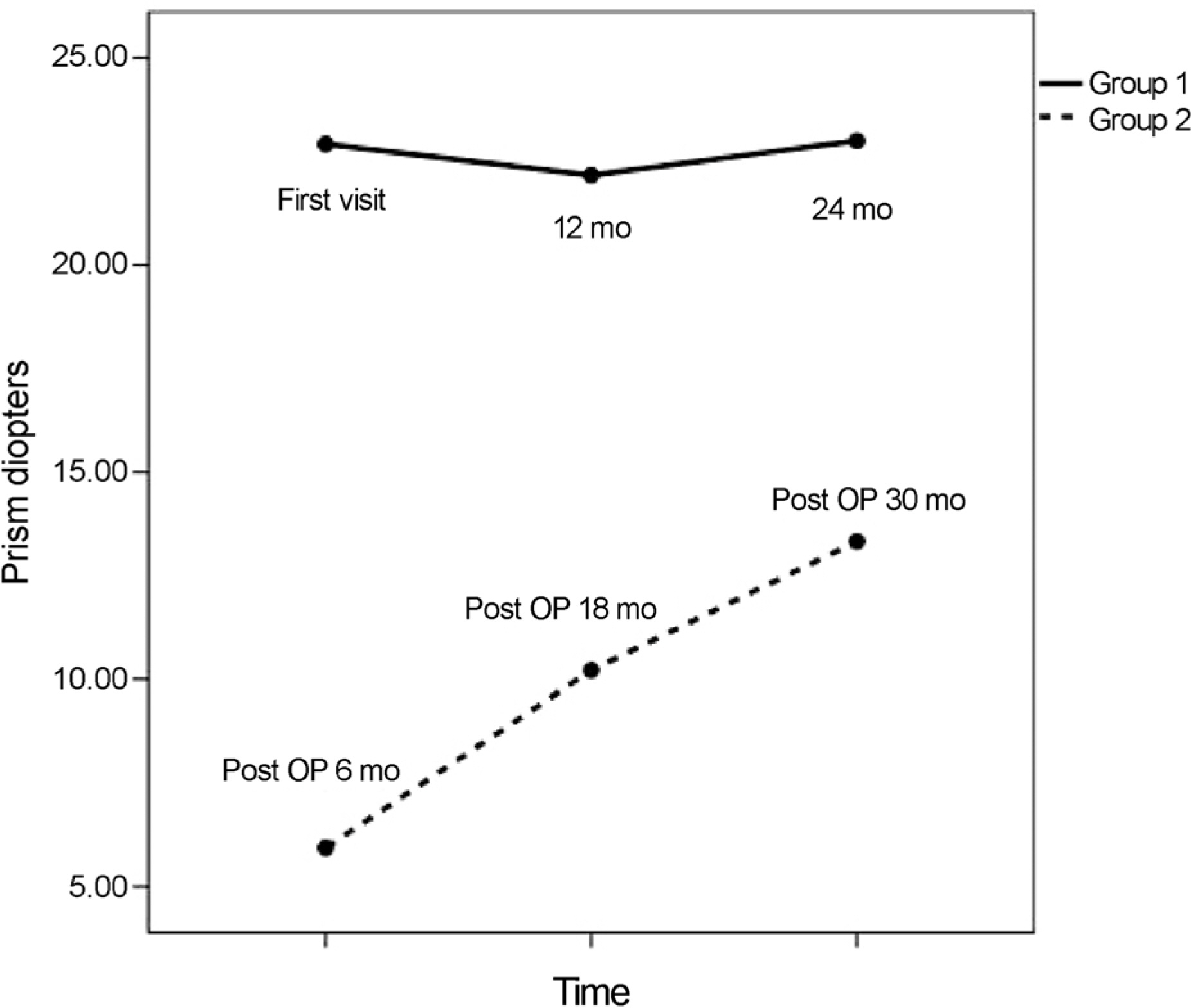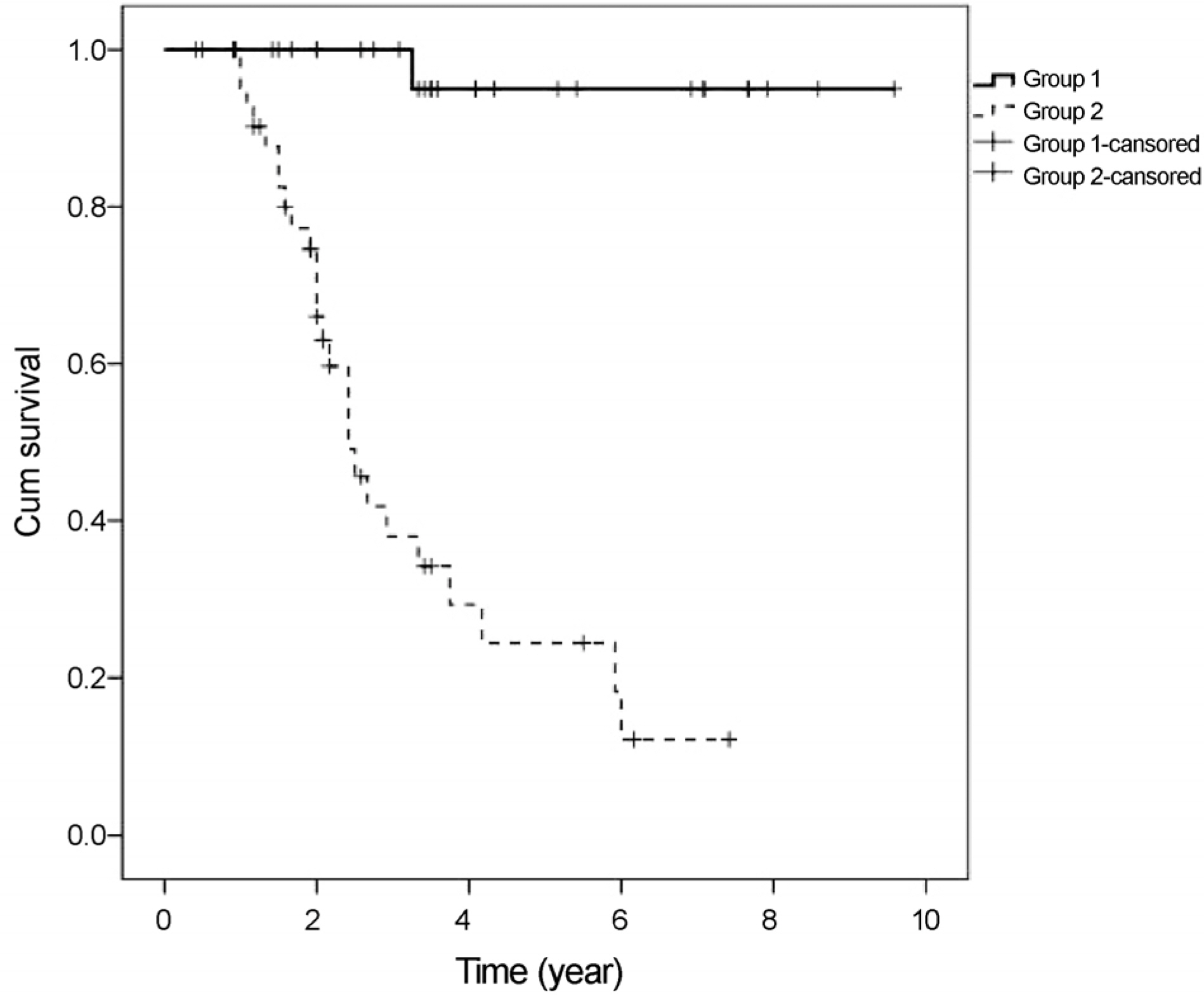J Korean Ophthalmol Soc.
2017 Oct;58(10):1169-1175. 10.3341/jkos.2017.58.10.1169.
Comparison of Exodrift between Natural Group and Postoperative Group in Intermittent Exotropia Patients
- Affiliations
-
- 1Department of Ophthalmology, Dankook University College of Medicine, Cheonan, Korea. kseeye@hanmail.net
- KMID: 2393169
- DOI: http://doi.org/10.3341/jkos.2017.58.10.1169
Abstract
- PURPOSE
To compare the exodrift between unilateral lateral rectus (ULR) recession and observation groups in moderate angle intermittent exotropia (IXT).
METHODS
A retrospective study was performed in 769 patients who were diagnosed with IXT from 2005 to 2015. Seventy-six patients were enrolled in this study that presented with IXT of 20 to 25 prism diopters (PD) on their first visit and were observed for more than 6 months without or after operation. The observation group (group 1) was composed of 29 patients who had regular examination without operation. The surgery group (group 2) was composed of 47 patients with ULR recession that were observed for deviation changes since surgery.
RESULTS
The mean age was 71.8 ± 22.0 months at first visit in group 1 and 91.1 ± 18.9 months before surgery in group 2 (p < 0.01). The distant exodeviation was 22.9 ± 2.5 PD at first visit in group 1 and 22.9 ± 2.4 PD before surgery in group 2 (p = 0.89). During follow-up, mean exodrift was 0.6 ± 9.0 PD in group 1 and 10.0 ± 7.4 PD in group 2 (p < 0.01). Exodrift up to postoperative 6 months in group 2 was 3.2 ± 4.0 PD and exodrift from postoperative 6 months to 2 years in group 2 was 7.1 ± 6.9 PD. More exodrift was noticed after post-operative 6 months (p = 0.04).
CONCLUSIONS
Comparing the exodrift between the groups in moderate angle IXT, patients in the observation group showed less exodrift. Patients who had a ULR recession presented more exodrift after postoperative 6 months. Even though they were orthotropic at postoperative 6 months when the operation was thought to be stabilized, an increase in exodrift after postoperative 6 months could not be excluded.
Figure
Reference
-
References
1. Jenkins R. Demographics: geographic variations in the prevalence and management of exotropia. Am Orthopt J. 1992; 42:82–7.
Article2. Park DG, Moon SH, Noh DH, Kim MM. Comparison between 20 and 25 prism diopters in bilateral rectus muscle recession for abdominal exotropia. J Korean Ophthalmol Soc. 2014; 55:1669–73.3. von Noorden GK, Campos EC. Binocular vision and ocular abdominal: theory and management of strabismus. 6th ed.St. Louis: Mosby;2002. p. 631.4. Burian HM. Exodeviations: their classification, diagnosis, and treatment. Am J Ophthalmol. 1966; 62:1161–6.
Article5. Scott WE, Keech R, Mash AJ. The postoperative results and stabdominal of exodeviations. Arch Ophthalmol. 1981; 99:1814–8.6. Ruttum MS. Initial versus subsequent postoperative motor abdominal in intermittent exotropia. J AAPOS. 1997; 1:88–91.7. Reynolds JD, Hiles DA. Single lateral rectus muscle recession for small angle exotropia. Reinecke RD, editor. Strabismus 2: Proceedings of the Fourth Meeting of the International Strabismological Association, October 25–29, 1982, Asilomar, California (Pt. 2). New York: Grune & Stratton;1984. p. 247–53.8. Kushner BJ. Selective surgery for intermittent exotropia based on distance/near differences. Arch Ophthalmol. 1998; 116:324–8.
Article9. Lee SH, Kim JY, Kwon JY. The effect of unilateral lateral rectus abdominal for the treatment of moderate-angle exotropia. J Korean Ophthalmol Soc. 2005; 46:2045–9.10. Spierer O, Spierer A, Glovinsky J, Ben-Simon GJ. Moderate-abdominals exotropia: a comparison of unilateral and bilateral rectus abdominal recession. Ophthalmic Surg Lasers Imaging. 2010; 41:355–9.11. Menon V, Singla MA, Saxena R, Phulijele S. Comparative study of unilateral and bilateral surgery in moderate exotropia. J Pediatr Ophthalmol Strabismus. 2010; 47:288–91.
Article12. Moon KJ, Choi WC, Park C. The long-term effect of unilateral abdominal rectus muscle recession for moderate angle exotropia. J Korean Ophthalmol Soc. 1998; 39:1885–90.13. Hiles DA, Davies GT, Costenbader FD. abdominal observations on unoperated intermittent exotropia. Arch Ophthalmol. 1968; 80:436–42.14. Sanfilippo S, Clahane AC. The effectiveness of orthoptics alone in selected cases of exodeviation: the immediate results and several years later. Am Orthopt J. 1970; 20:104–17.
Article15. Kii T, Nakagawa T. Natural history of intermittent exotropia–stat-istical study of preoperative strabismic angle in different age groups. Nippon Ganka Gakkai Zasshi. 1992; 96:904–9.16. Romanchuk KG, Dotchin SA, Zurevinsky J. The natural history of surgically untreated intermittent exotropia-looking into the distant future. J AAPOS. 2006; 10:225–31.
Article17. Yang HK, Hwang JM. Bilateral vs unilateral medial rectus abdominal for recurrent exotropia after bilateral lateral rectus recession. Am J Ophthalmol. 2009; 148:459–65.18. Cho SC, Yang HK, Hwang JM. Three-year surgical outcome of exotropia. J Korean Ophthalmol Soc. 2012; 53:1674–9.
Article19. Lee JC, Lee YC, Lee SY. Comparison of postoperative outcomes according to deviation angle in moderate-angle intermittent abdominal of basic type. J Korean Ophthalmol Soc. 2013; 54:475–8.20. von Noorden GK. Binocular vision and ocular motility: theory and management of strabismus. 4th ed.St. Louis: CV Mosby;1990. p. 330–9.21. Stathacopoulos RA, Rosenbaum AL, Zanoni D, et al. Distance stereoacuity. Assessing control in intermittent exotropia. Ophthalmology. 1993; 100:495–500.22. Zanoni D, Rosenbaum AL. A new method for evaluating distance stereo aciuty. J Pediatr Ophthalmol Strabismus. 1991; 28:255–60.23. Roh YB, Kim CM, Oum BS, Lee JS. Distance stereoacuity in abdominal with intermittent exotropia using B-VAT II video acuity tester. J Korean Ophthalmol Soc. 1998; 39:578–82.24. Suh WJ, Lee UK, Kim MM. Change of postoperative distance abdominal in intermittent exotropic patients. J Korean Ophthalmol Soc. 2000; 41:758–63.25. O'Neal TD, Rosenbaum AL, Stathacopoulos RA. Distance stereo acuity improvement in intermittent exotropic patients following strabismus surgery. J Pediatr Ophthalmol Strabismus. 1995; 32:353–7. discussion 358.26. Beneish R, Flanders M. The role of stereopsis and early abdominal alignment in long-term surgical results of intermittent exotropia. Can J Ophthalmol. 1994; 29:119–24.27. Baker JD, Davies GT. Monofixational intermittent exotropia. Arch Ophthalmol. 1979; 97:93–5.
Article28. Kim JH, Kim SH, Cho YA. A Study of patient concerns and return to daily life after strabismus surgery. J Korean Ophthalmol Soc. 2012; 53:440–5.
Article29. Baek SU, Lee JY. abdominal outcome of surgery for intermittent exotropia. J Korean Ophthalmol Soc. 2013; 54:1079–85.30. Cho YA, Lee JK. Early surgery before 4 years of age in intermittent exotropia. J Korean Ophthalmol Soc. 2004; 45:620–5.31. Ing MR, Nishimura J, Okino L. Outcome study of bilateral lateral rectus recession for intermittent exotropia in children. Ophthalmic Surg Lasers. 1999; 30:110–7.
Article32. Kim MM, Cho ST. abdominal surgical results of intermittent exotropia. J Korean Ophthalmol Soc. 1994; 35:1321–6.33. Nelson LB, Bacal DA, Burke MJ. An alternative approach to the surgical management of exotropia–the unilateral lateral rectus recession. J Pediatr Ophthalmol Strabismus. 1992; 29:357–60.
Article34. Weakley DR Jr, Stager DR. Unilateral lateral rectus recessions in exotropia. Ophthalmic Surg. 1993; 24:458–60.
Article35. Roh YB, Choi HY. Surgical results of unilateral and bilateral lateral rectus recessions in exotropia under 25 prism diopter. J Korean Ophthalmol Soc. 1997; 38:474–8.36. Cho HJ, Ma YR, Park YG. Comparison of surgical results between bilateral and unilateral lateral rectus recession in 20∼ 25 prism abdominal intermittent exotropia. J Korean Ophthalmol Soc. 2002; 43:1993–9.37. Rabb EL, Parks MM. Recession of the lateral recti. Early and late postoperative alignments. Arch Ophthalmol. 1969; 82:203–8.38. Knapp P. Symposium on strabismus: transactions of the New Orleans Academy of Ophthalmology. St. Louis: CV Mosby;1971. p. 233–41.39. Roh JH, Paik HJ. Clinical study on factors associated with abdominal and reoperation in intermittent exotropia. J Korean Ophthalmol Soc. 2008; 49:1114–9.40. Lee S, Lee YC. Relationship between motor alignment at abdominal day 1 and at year 1 after symmetric and asymmetric abdominal in intermittent exotropia. Jpn J Ophthalmol. 2001; 45:167–71.41. Elsas FJ. Consecutive esotropia. Am Orthopt J. 1992; 42:94–7.
Article42. Duane A. A New Classification of the Motor Anomalies of the Eye: Based upon Physiological Principles, Together with Their Symptoms, Diagnosis and Treatment. New York: J.H. Vail & Co.;1897. p. 49–51.43. Bielschowsky A. Divergence excess. Arch Ophthalmol. 1934; 12:157–66.
Article
- Full Text Links
- Actions
-
Cited
- CITED
-
- Close
- Share
- Similar articles
-
- Postoperative Exodrift Patterns after Bilateral or Unilateral Lateral Rectus Recession in 20 Prism-diopter Intermittent Exotropia
- Myopic Progression and Postoperative Exodrift in Patients with Intermittent Exotropia
- Long-term Surgical Outcomes of Initial Postoperative Overcorrection in Adults with Intermittent Exotropia
- Clinical Manifestations and Surgical Outcomes of Intermittent Exotropia with or without Dissociated Vertical Deviation
- The influence of fusional divergence on the surgical results in intermittent exotropia



